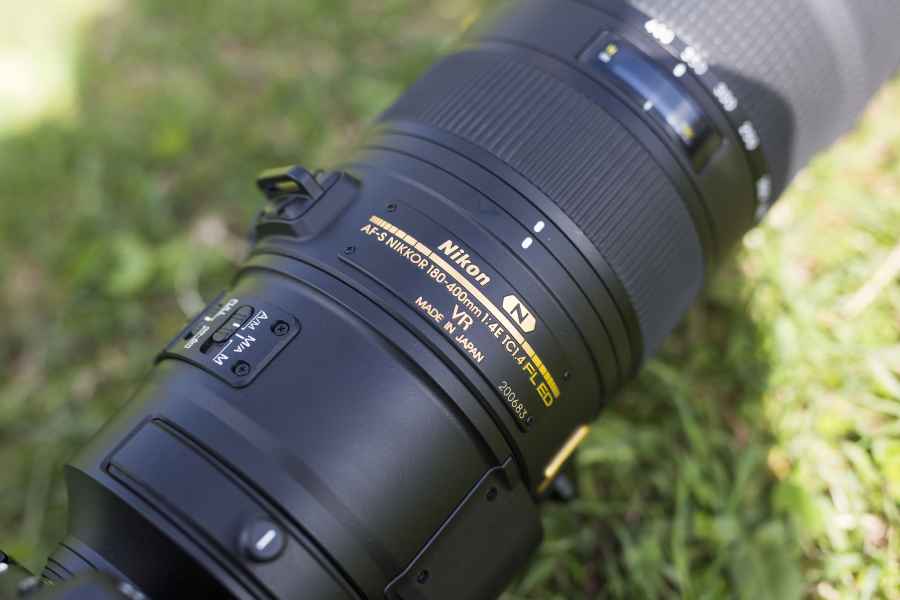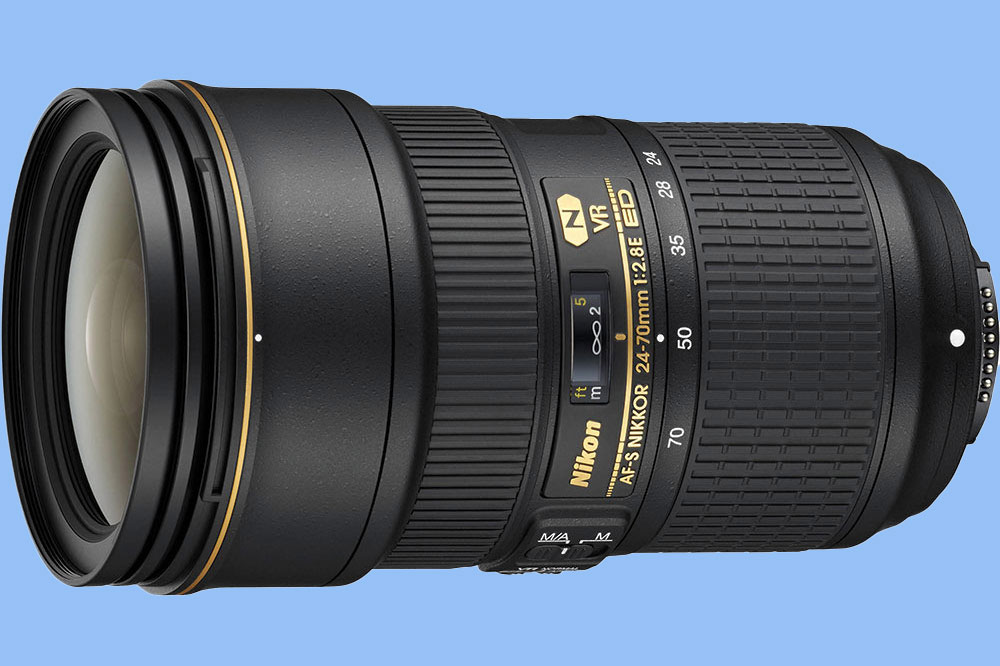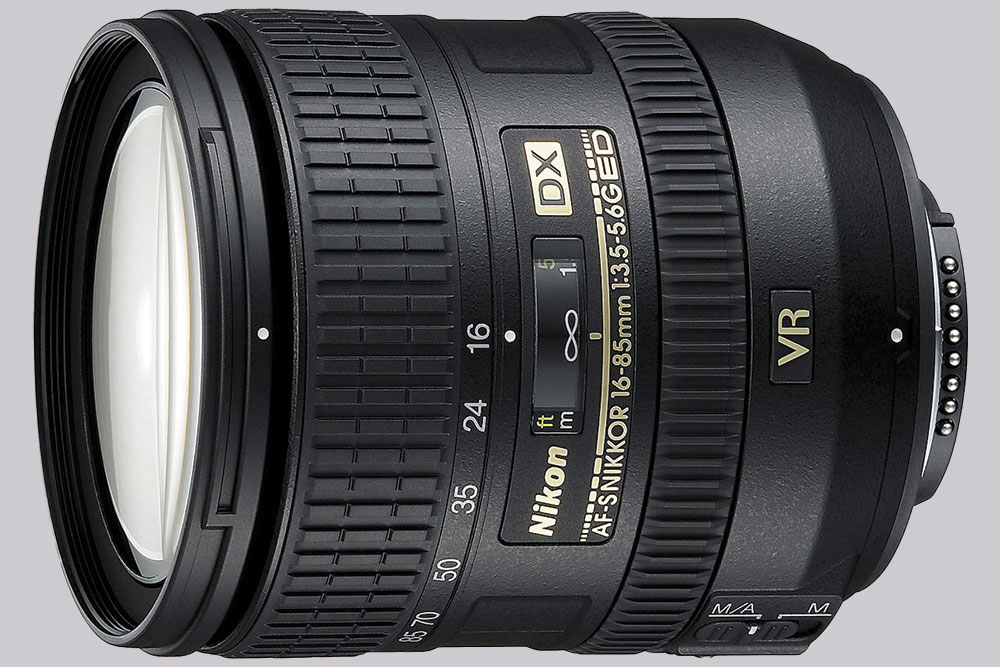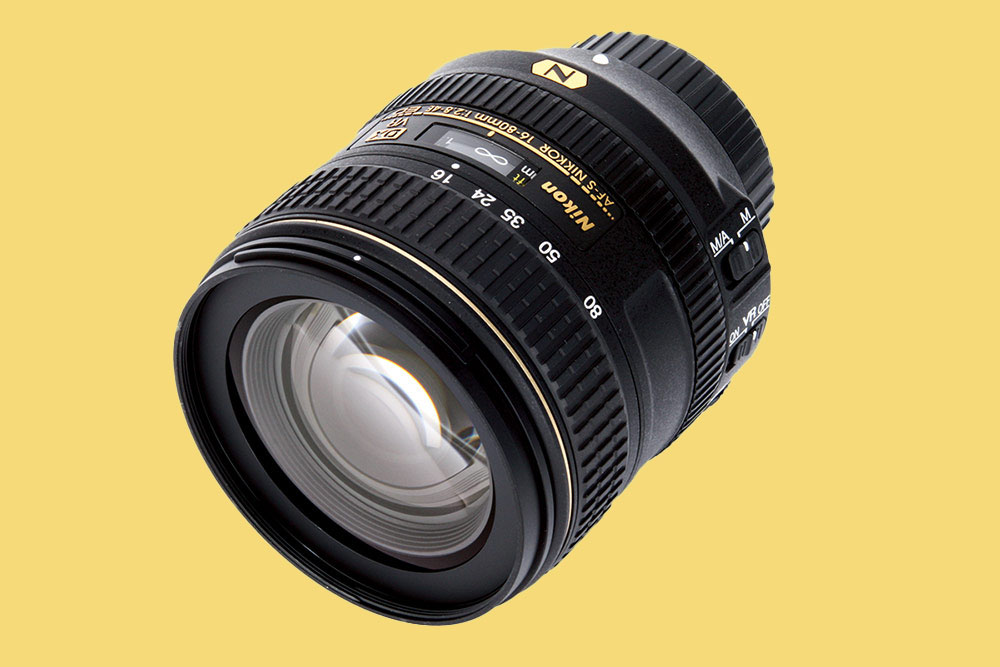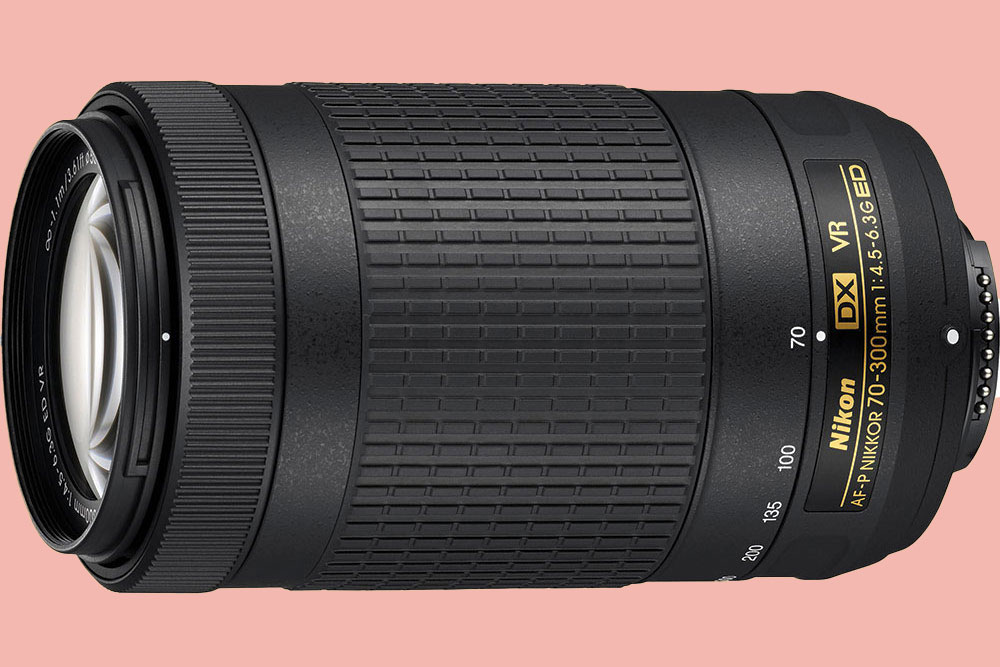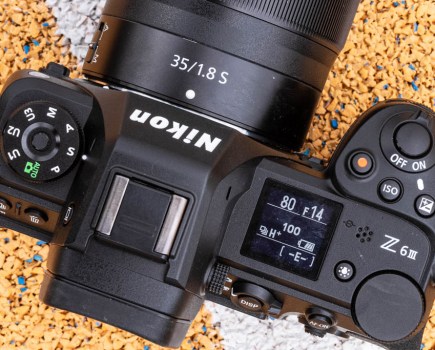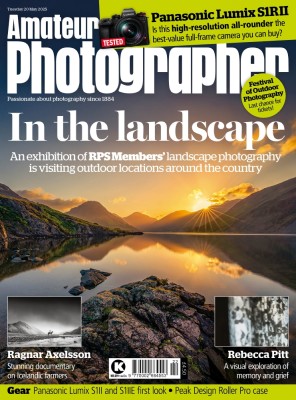Welcome to our guide to the best lenses for Nikon F-mount cameras. Here we select the best of the best lenses for Nikon full-frame and APS-C DSLRs based on the many that we’ve tested and reviewed over the years. The F-mount underpins Nikon’s legendary system of DSLRs: some of these models are among our top-rated DSLRs ever made.
These F-mount lenses aren’t just for Nikon DSLRs, however. Thanks to Nikon’s FTZ mount adapters, Nikon F lenses can be also be used on the best Nikon mirrorless cameras in the Z system. In most cases, they’ll work with full functionality of autofocus and stabilisation, so owners of mirrorless cameras will also find bargains from our list. It includes a mix of lenses available new and some only available second-hand for bigger savings.
If you’re new to buying lenses and need a primer, scroll to the bottom of the page where we’ve included an explainer section of key specs with answers to some frequently asked questions.
The best Nikon lenses for F-mount: quick list
Looking for the best deal on Nikon lenses? Not only will you find the best Nikon lenses, but also some of the best Nikon lens deals, as our ‘Buy now’ buttons are set to automatically take you to the best prices from trusted retailers. You’ll also find a list of other retailers below each lens, so you can find the right deal for you.
Here’s our quick list of the best Nikon F-mount lenses you can buy…
- Best Nikon lens overall: AF-S Nikkor 24-70mm f/2.8E ED VR – Buy now
- Best Nikon lens for landscapes: AF-S Nikkor 14-24mm f/2.8G ED – Buy now
- Best Nikon superzoom: Nikon 28-300mm f/3.5-5.6G VR – Buy now
- Best Nikon portrait lens: AF-S Nikkor 85mm f/1.8G – Buy now
- Best Nikon 50mm lens: AF-S Nikkor 50mm f/1.8G – Buy now
- Best wide-angle prime lens: AF-S Nikkor 20mm f/1.8G ED – Buy now
- Best Nikon lens for wildlife: AF-S 500mm f/5.6E PF ED VR – Buy now
- Best Nikon lens for sports: AF-S 180-400mm f/4E TC1.4 FL ED VR – Buy now
Best APS-C DX lenses for Nikon:
- Best cheap Nikon zoom: AF-S DX 16-85mm f/3.5-5.6G ED VR (APS-C) – Buy now
- Best standard zoom: Nikon AF-S DX Nikkor 16-80mm F2.8-4E ED VR (APS-C) – Buy now
- Best Nikon tele zoom: AF-P DX 70-300mm f/4.5-6.3 G ED VR (APS-C) – Buy now
- Best Nikon wide-angle zoom: AF-P DX 10-20mm f/4.5-5.6G VR (APS-C) – Buy now
- Best Nikon street lens: AF-S DX Nikkor 35mm f/1.8G (APS-C) – Buy now
Why you can trust Amateur Photographer
We spend many hours testing every product we recommend, in detail, in a variety of situations and shooting scenarios, and only use experts for our reviews, so you can be sure that you’re getting the best products. Find out more about our expert writers.
Continue reading to find out more about why we’ve chosen these lenses…
Best Nikon lens overall
AF-S Nikkor 24-70mm f/2.8E ED VR
Amateur Photographer verdict
A superb, multi-purpose standard zoom perfect for most shooting environments as well as portraiture- VR adds shooting flexibility
- Hugely impressive autofocus
- Excellent quality throughout zoom range
- Some vignetting when wide open
- Steep asking price
At a glance:
- Full-frame (FX)
- Minimum focus distance: 0.38m
- Weight: 900g
- New price: $2,097 / £2,099 (nikon.co.uk)
- Used in good or better condition $1,400 – $1,500 / £700 – £1,100
Sometimes only the very best will do, and when it comes to standard zooms on a full-frame Nikon body, this is it. The latest version of Nikon’s pro workhorse lens adds optical image stabilisation and uses an electromagnetic diaphragm, which provides much-improved functionality when shooting in live view, and for video work.
With an array of exotic glasses and coatings, it’s designed for use on the latest high-resolution DSLRs such as the 45.7MP Nikon D850. It can also be used with DX-format cameras, giving a 36-105mm equivalent range.
Super-fast autofocus and top-notch build quality round off a truly excellent package. Overall, it’s a superb, fast standard zoom that is perfect for a range of shooting environments.
Read our Nikon AF-S 24-70mm f/2.8E ED VR review.
Best Nikon lens for landscapes
AF-S Nikkor 14-24mm f/2.8G ED
Amateur Photographer verdict
Great overall sharpness and optical performance, a solid chioce for landscape photographers- Outstanding optical performance
- Constant f/2.8 aperture
- Solidly built with weather sealing
- Won’t take screw-on filters
- Pretty heavy
At a glance:
- Full-frame (FX)
- Minimum focus distance: 0.28m
- Weight: 1,000g
- New price: $1,747 / £1,711
- Used in good or better condition from $760 / £900
This lens is legendary in landscape photography circles. If you’ve seen any competition shortlists for landscape photography in the past 10 years, then you’ve seen an image taken with it.
The Nikkor AF-S 14-24mm f/2.8G ED was introduced in 2007, and is quite simply a beautiful feat of optical engineering. It delivers images of outstanding sharpness thanks to its extra-low dispersion elements and the Nano Crystal Coating and Super Integrated Coating that have been added. It’s also weather-sealed, and the constant aperture of f/2.8 enables real creative freedom.
Sure, you don’t get more modern features like lightning-fast autofocus and optical stabilisation, but landscape photographers don’t really need them. The main thing that’s likely to annoy landscape shooters is the fact that you can’t attach filters to the bulbous front element. Workarounds exist, such as the Lee Filters SW150 system, but they will add to the cost of the lens, so bear that in mind.
Best Nikon superzoom
Nikon 28-300mm f/3.5-5.6G VR
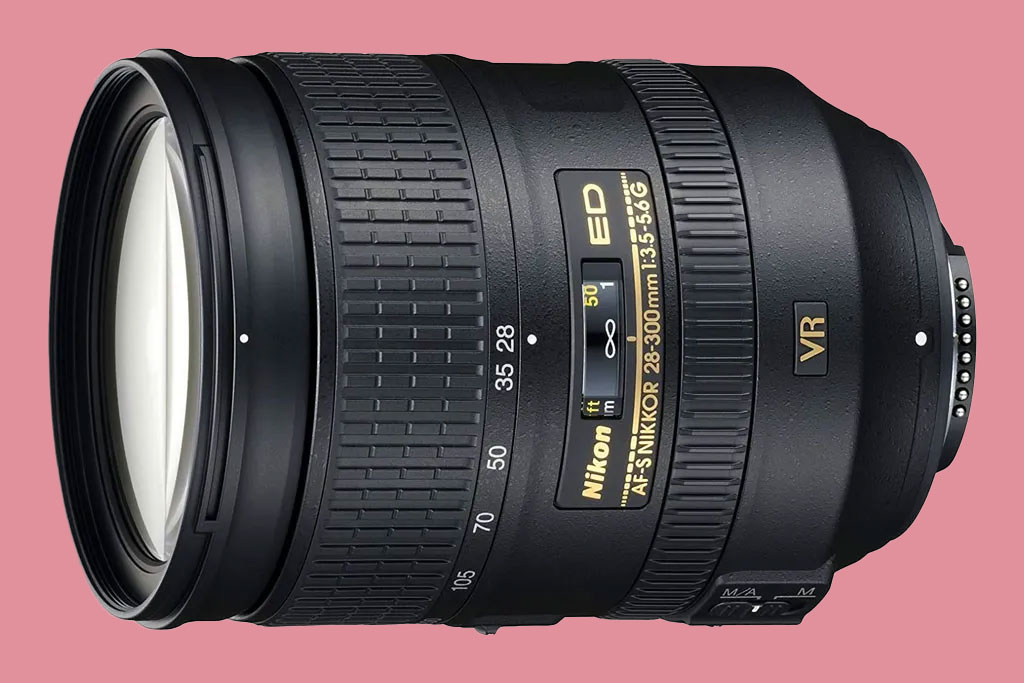
Amateur Photographer verdict
Covers a very generous focal length range, and despite the variable aperture its an ideal all-in-one lens- Good sharpness for a superzoom
- All-in-one convenience
- Effective Vibration Reduction
- Pedestrian maximum aperture
- No aperture ring
At a glance:
- Full-frame (FX)
- Minimum focus distance: 0.5m
- Weight: 800g
- Used: from $430 / £370
A discontinued lens that can still be acquired at a good price second-hand, the Nikon 28-300mm f/3.5-5.6G VR delivers unparalleled versatility for a Nikon DSLR user. It’s one of the few superzoom lenses that’s compatible with full-frame. Does it deliver the kind of optical quality you get from Nikon’s prime lenses? No, of course not – but it does pretty well across the entire zoom range, and you won’t have any problem shooting dynamic, striking images with it.
One downside is the rather uninspiring maximum aperture of f/3.5-5.6. This is part and parcel of keeping the lens to a sensible weight and cost, but all the same, those who want to create striking shallow depth of field or beautiful bokeh will want to look elsewhere.
We should also mention the Vibration Reduction (VR) functionality, which really does work well in low light. Much slower shutter speeds than normal still produce sharp pictures, which makes this lens an ideal all-in-one, carry-everywhere choice.
Best Nikon portrait lens
AF-S Nikkor 85mm f/1.8G
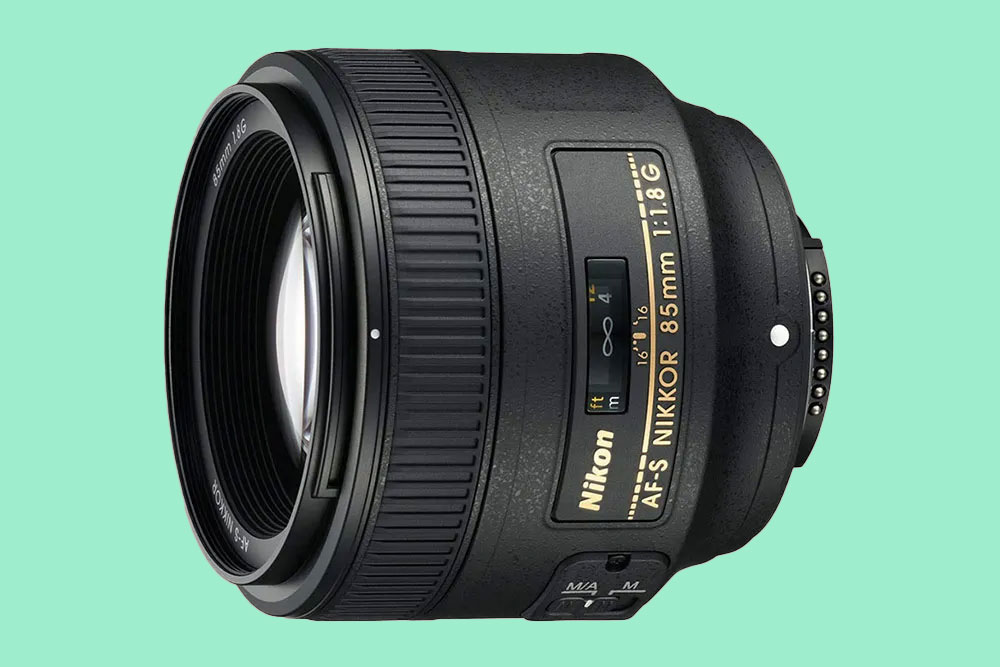
Amateur Photographer verdict
A good choice if you don’t want to break the bank but are looking for a dedicated, fast portrait lens with reasonable sharpness- Solid budget portrait lens
- Produces attractive bokeh
- Useful f/1.8 aperture
- Not as sharp as some portrait lenses
At a glance:
- Full-frame (FX)
- Minimum focus distance: 0.8m
- Weight: 350g
- New price: $477 / £480
- Used price: $235-275/ £220-300
To take portraits to a higher level, then a large-aperture, short-telephoto prime is the way to go. Nikon’s AF-S 85mm f/1.8 is a good quality yet reasonably affordable choice, with fast autofocus and sharp optics. With a nine-bladed circular aperture, it can also provide very attractively blurred backgrounds. The lens is also nice and light, weighing less than the previous version despite having a more complex optical interior with more glass elements. The front of the lens doesn’t rotate when focusing, meaning you can freely use circular filters.
The lens is equally suitable for use on full-frame and DX format DSLRs, giving a 135mm view on the latter. To get even better results, you’d need to invest in an 85mm f/1.4, with Sigma’s 85mm f/1.4 Art DG HSM ($1,199 / £999) being a fine example. If you don’t have that kind of budget, this is a very tempting alternative.
Best Nikon 50mm lens
AF-S Nikkor 50mm f/1.8G

Amateur Photographer verdict
A capable optical performer turning in images with good contrast, reduced chromatic aberrations and high sharpness. Autofocus is fast and quiet.- Curved aperture blades
- Nice and cheap
- Good sharpness
- Some curvilinear distortion
At a glance:
- Full-frame (FX)
- Minimum focus distance: 0.45m
- Weight: 185g
- Price: $217 / £219
- Used price: $180 / £90 – £110
For many years, 50mm primes (or ‘nifty fifties’) were sold as general-purpose lenses with 35mm film cameras, but they fell out of favour for a few decades. Recently, however, there has been a resurgence in their popularity for use with APS-C format DSLRs. They tend to be small, light and relatively cheap, yet very sharp, and perfect for shooting portraits.
Nikon’s AF-S 50mm f/1.8G is a classic example of the type, and will also work on full-frame cameras. We found it performed well across the board. Overall, Nikon has succeeded in taking a classic design and making it even better.
The lens has a 58mm filter thread and a construction of seven elements in six groups. Don’t confuse it with the cheaper AF 50mm f/1.8D, which won’t autofocus on Nikon’s entry-level D3000-series or D5000-series DSLRs.
Read our Nikon AF-S Nikkor 50mm f1.8G review
Find more 50mm options in our guide to the best 50mm prime lenses.
Best Nikon wide-angle prime lens
AF-S Nikkor 20mm f/1.8G ED
Amateur Photographer verdict
This bright prime delivers, even though it’s discontinued. Resolution is best at f/5.6-f/8, with only the very corners of the image showing a slight blur.- Bright aperture
- High resolution
- Old age
At a glance:
- Full-frame (FX)
- Minimum focus distance: 0.20m
- Weight: 355g
- New price: $797 / £799
- Used price: from $420 / £400
The Nikon AF-S Nikkor 20mm f/1.8G ED is a high-quality wide-angle prime lens, giving high-quality images, particularly at f/5.6-f/8 where we found it gave impressive resolution. It was only in the very corners of the image where we found slight blur. Distortion is also kept well controlled, with minimal vignetting and chromatic aberration. These are solved in-camera if you shoot JPEG images, or alternatively can be quickly fixed in photo editing software.
The brighter f/1.8 aperture will be of benefit to those shooting in low-light conditions, and we expect those interested in astrophotography would be well served by this lens.
Read our Nikon AF-S Nikkor 20mm f/1.8G ED review
Best Nikon lens for wildlife
AF-S 500mm f/5.6E PF ED VR

Amateur Photographer verdict
If you know you shoot most of your shots around the 500mm mark and want the best you can get at this focal length, you’ll struggle to find a better lens for the money.- Terrific optical performance
- Fast focusing
- 4-stop stabilisation
- Very light for this focal length
- Expensive
At a glance:
- Full-frame (FX)
- Minimum focus distance: 3.0m
- Weight: 1,460g
- New price: $3,597 / £3,449
- Used price: from $1,650-1,870 / from £1,600
The Nikon AF-S 500mm f/5.6E PF ED VR lens is the lightest 500mm full-frame telephoto prime lens; weighing just 1.46kg, it is lighter than most 150-600mm zoom lenses – light enough to shoot with handheld. The Vibration Reduction system gives 4-stops of stabilisation.
The lens gives impressive image quality, as well as rapid focus performance, making it ideal for when a telephoto prime lens is required. When we took the lens to Lords Cricket Ground for a sporting field test, we discovered just how well it delivers the goods: ‘If I were a Nikon user planning to go on safari, I’d put my name down to hire this lens…’ noted our reviewer at the time.
Read our Nikon AF-S Nikkor 500mm f/5.6E PF ED VR field test
Best Nikon lens for sports
AF-S 180-400mm f/4E TC1.4 FL ED VR
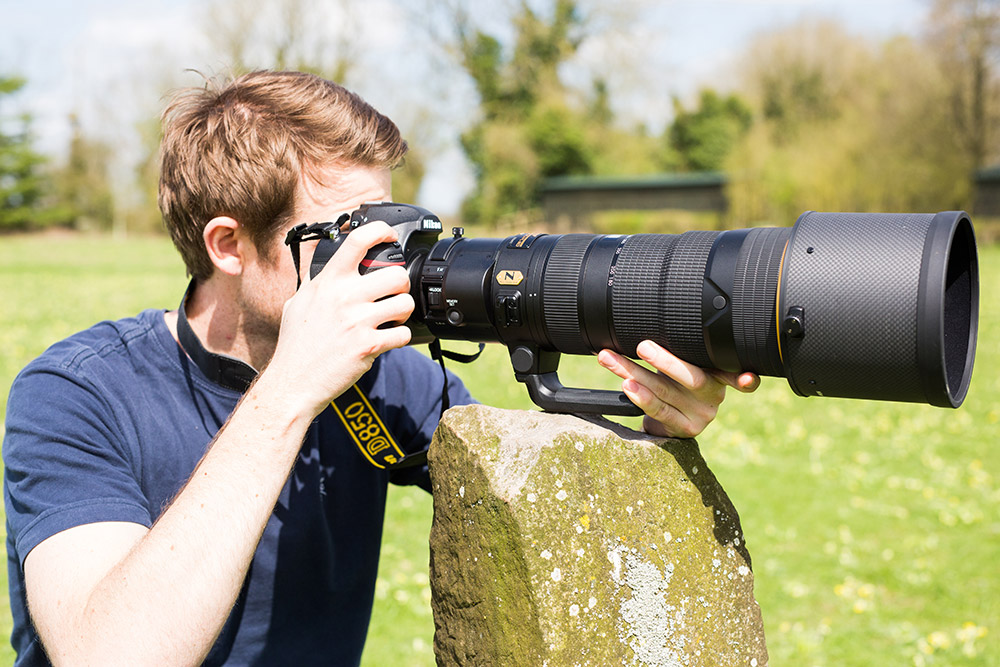
Amateur Photographer verdict
If money was no object and you’re a Nikon user who requires the very best zoom lens to get up close to distant subjects, you’d put your name down for this lens in an instant.- Built-in teleconverter
- Superb imaging performance
- Very heavy
- Very, very expensive
At a glance:
- Full-frame (FX)
- Minimum focus distance: 2.0m
- Weight: 3,500g
- Price: $12,397 / £10,999
- Used price $8,000 (renewed) / around £5,000
For those blessed with the budget, Nikon’s AF-S Nikkor 180-400mm f/4E TC1.4 FL ED VR lens offers not only a 180-400mm telephoto zoom, but also features a built-in 1.4x teleconverter. With the new price of $12,396 / £10,999, it might be a lens to consider hiring for special shoots.
It’s worth noting that, due to its 3.5kg weight, you might not want to carry it around for too long. A monopod can help out here, as we discovered when we took it for a review at a bird-in-flight workshop. Nikon has created an absolutely sensational lens, but the high price will have the final say over the number of photographers who get to use it.
It certainly delivers impressive image quality though, with Vibration Reduction helping to keep shots steady, for which it is to be commended.
Read our Nikon AF-S 180-400mm f/4E TC1.4 FL ED VR field test
Best cheap Nikon zoom
AF-S DX 16-85mm f/3.5-5.6G ED VR
Amateur Photographer verdict
An affordable standard zoom alternative for a crop sensor DSLR, with image stabilisation and fast autofocus. However, with variable aperture, it might struggle in low light.- Excellent value for money
- Broad, do-everything zoom range
- Fast autofocus
- Somewhat slow maximum aperture
- Not compatible with full-frame
At a glance:
- APS-C (DX)
- Minimum focus distance: 0.38m
- Weight: 485g
- Price (used): $450 – $560 / from £200
If you’ve outgrown the 18-55mm kit zoom that came when you bought your camera, this might just be the perfect upgrade. It offers a usefully extended zoom range, from 24mm equivalent wide-angle to 128mm telephoto, while providing a respectable optical performance that’s aided by a fast ultrasonic-type autofocus motor and built-in image stabilisation.
The maximum aperture is relatively slow, running from f/3.5 to f/5.6 once you’ve zoomed in. This will be fine for most day-to-day shooting, but you may start to struggle once light levels start to get low – though the aforementioned stabilisation will help by letting you get away with slower shutter speeds to let in more light.
This lens has been on the market for almost a decade now, meaning good prices can often be had if you’re prepared to shop around.
Best Nikon standard zoom
Nikon AF-S DX Nikkor 16-80mm f/2.8-4E ED VR
Amateur Photographer verdict
If you want a standard zoom to partner your Nikon DX-format DSLR with a very useful focal length and a relatively fast VR lens, then a used, good condition sample is worth seeking out.- Reliable autofocus
- Generally good image quality
- Good price on used market
- Plasticky construction
- Some optical shortfalls at edges
At a glance:
- APS-C (DX)
- Minimum focus distance: 0.35m
- Weight: 480g
- Price (Amazon): $1,067 / £390 (used)
An upmarket version of Nikon’s standard zoom, the AF-S DX Nikkor 16-80mm f/2.8-4E ED VR commands a premium in price. However, for the money, you do get a more generous maximum aperture of f/2.8-4. What’s more, the price gap between the 16-80mm f/2.8-4E and the 16-85mm f/3.5-5.6 has narrowed now that both are on the second-hand market. New, there would have been about $300/£300 between them; now it’s more like $100/£100.
This makes the AF-S DX Nikkor 16-80mm f/2.8-4E ED VR highly attractive, and as we noted in our review, it’s an excellent lens all-around. Vibration Reduction (optical image stabilisation), an electromagnetic diaphragm, a 5x zoom and the aforementioned generous maximum aperture, all wrapped up in a lightweight body make it impressive. Our AF-S DX Nikkor 16-80mm f/2.8-4E ED VR test results showed good centre sharpness, with some expected drop-off in the corners, especially at large apertures.
Best Nikon tele zoom
AF-P DX 70-300mm f/4.5-6.3 G ED VR
Amateur Photographer verdict
A useful telephoto zoom for APS-C format, image stabilised optics and the silent motor autofocus makes it suitable for video as well.- Useful zoom range
- Silent autofocus
- Very good value
- Incompatible with full-frame Nikon DSLRs
At a glance:
- APS-C (DX)
- Minimum focus distance: 1.1m
- Weight: 415g
- Price: $397 (new), from $260 (used) / £315 (reconditioned)
Often the first lens DSLR users buy after the 18-55mm that came with their camera is a telephoto zoom. But there’s a huge number to choose from, with Nikon alone offering six for its DX-format SLRs, distinguished only by opaque combinations of letters in their names.
The most up-to-date is the AF-P 70- 300mm f/4.5-6.3 VR: a compact, image-stabilised optic with a usefully long zoom range and the latest fast, silent AF-P motor for autofocus that’s also suitable for video work.
Being an AF-P lens, though, it’s not compatible with Nikon DSLRs that were released five years or more ago – if you use an older model, you’ll need to buy the Nikon AF-S DX Nikkor 55-300mm f/4.5-5.6G ED VR.
Best Nikon wide-angle zoom
AF-P DX 10-20mm f/4.5-5.6G VR

Amateur Photographer verdict
Not ideal for large prints or if you tend to scrutinise in detail when viewing on screen, but if you can accept this, you get a lightweight, super-wide angle zoom with stabilisation.- Excellent built-in stabilisation
- Useful focal range
- Lacks sharpness
- Not compatible with everything
At a glance:
- APS-C (DX)
- Minimum focus distance: 0.22m
- Weight: 230g
- New price: $397 / £309
- Used price: $220 – $280 / £220 – £280 (used)
Nikon DSLR users had long been crying out for a lightweight, inexpensive wide-angle zoom, and finally it arrived in the shape of this 10-20mm lens for APS-C (its focal range works out to an equivalent of 15-30mm when mounted on DX cameras). Optically it’s OK, if not outstanding, but the short minimum focus distance provides plenty of versatility, making it a solid jack-of-many-trades for a reasonable price. The built-in optical stabilisation (VR) is excellent, providing compensation equivalent to 3.5 stops. Arguably, it’s less useful on a wide-angle like this than it would be on a telephoto, but there’s no harm in having it, particularly if you plan to do a lot of low-light shooting.
Again, though, its AF-P designation means that it only works on relatively recent APS-C DSLRs, so check compatibility before you buy. Otherwise, this is a great complement to a standard zoom for subjects such as landscapes, interiors, real estate and architecture, where you’d like to squeeze as much as possible in the frame.
Read our review for the Nikon AF-P DX 10-20mm f/4.5-5.6G VR here.
Find more options in our picks of the best wide-angle zooms for landscape photography.
Best Nikon street lens: AF-S DX Nikkor 35mm f/1.8G
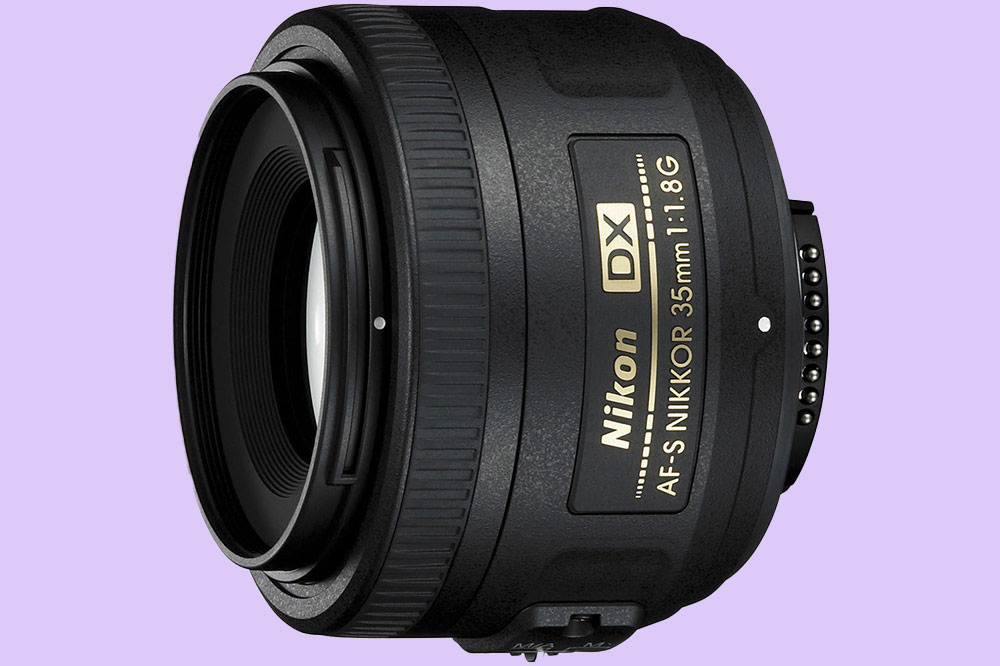
Amateur Photographer verdict
A bright, versatile and sharp standard prime in a small body. You get a super affordable ‘nifty fifty’ for your crop-sensor.- Excellent value for money
- Impressive sharpness
- Compact and lightweight
- Doesn’t work on full frame
At a glance:
- APS-C (DX)
- Minimum focus distance: 0.3m
- Weight: 200g
- New price: $197 / £169
- Used price: $79-100 / £74-100
- (nikon.com)
Large-aperture prime lenses allow you to shoot indoors without flash, or blur backgrounds for creative effect. Not only is this small 35mm prime one of the best Nikon lenses of its type for APS-C DSLR users, it’s also very sharp. With a view roughly equivalent to a 50mm prime on full-frame, it’s suitable for subjects from street photography to portraits.
For a lens that will also work on full-frame, you’ll need the similarly-named Nikon AF-S Nikkor 35mm f/1.8G, but this costs almost three times as much. Other important things to know about this lens are its 30cm minimum focus distance, it accepts filters and adapters via a 52mm thread and accepts Nikon’s HB-46 lens hood.
Read our article about the Nikon AF-S DX Nikkor 35mm f/1.8G here.
How to choose the best Nikon F-mount lenses
Which is the best Nikon F lens for your DSLR setup? As different lenses suit different kinds of subjects, the choice depends largely on what you plan to photograph. Here is a quick guide to the main considerations when picking a Nikon F lens.
DX or FX?
You’ll see these letters in the names of all Nikon F-mount lenses, and they refer to the sensor size of the camera they pair with. Nikon DSLRs come in two varieties – APS-C sensor (DX) and full-frame sensor (FX). A DX lens will create a smaller image circle, designed to fit a smaller APS-C sensor found on Nikon’s DX series DSLRs, such as the Nikon D5600.
- See our guide to APS-C vs full-frame for a thorough look at how it all works.
Prime or Zoom?
Prime lenses have a fixed focal length, while zoom lenses have a focal range that let you get closer to or further from your subject. Prime lenses produce superior optical quality, so picking between the two types is generally a choice between sharpness vs versatility.
- If you know you want a zoom, check out our guide to the best zoom lenses for Nikon DSLRs.
Focal length?
Wide-angle lenses (around 8-35mm) are good for capturing expansive scenes like landscapes, and conveying scale in architecture. Standard lenses (40-75mm) provide a natural perspective, useful for street photography and documentary photography. Telephoto lenses (80mm and higher) are good for bringing distant subjects like wildlife into sharp focus, or flattering facial features for portraits.
Maximum aperture?
An f/2.8 lens has a maximum aperture setting of f/2.8. The lower the number (eg f/1.4), the larger the aperture, and the more light a lens will let in. This also allows for shallow depth of field, which is handy for portraits. Some zoom lenses have a variable maximum aperture like f/3.5-5.6 – this means the maximum aperture changes depending on how far the lens is zoomed in.
VR?
On Nikon F-mount lenses this stands for Vibration Reduction; Nikon’s name for its optical image stabilisation system. Image stabilisation keeps a lens steady when it’s being hand-held, allowing for the use of slower shutter speeds without the need for a tripod.
Nikon F-mount lenses: FAQs
Here are the answers to a few of the most common questions we get about Nikon F-mount lenses.
FAQ: Is Nikon discontinuing F-Mount?
We’ve reported previously on 35 F-mount lenses being discontinued in recent years. Despite this, there are still a vast number of lenses available new, and in the used camera market. A discontinued lens may still be a very good, or indeed a great performing lens. The most recent Nikon DSLRs released were the Nikon D780 and Nikon D6 – both in 2020.
FAQ: Can you use Nikon F lenses on mirrorless cameras?
Yes. Nikon F-mount lenses can be used with Nikon mirrorless cameras, thanks to the FTZ or FTZ II mount adapters. In most cases, the adapter will give you full functionality of autofocus and stabilisation.
For more have a look at the latest news, lens reviews, and buying guides, or have a look at the best Nikon DSLRs, and the best Nikon mirrorless cameras.

